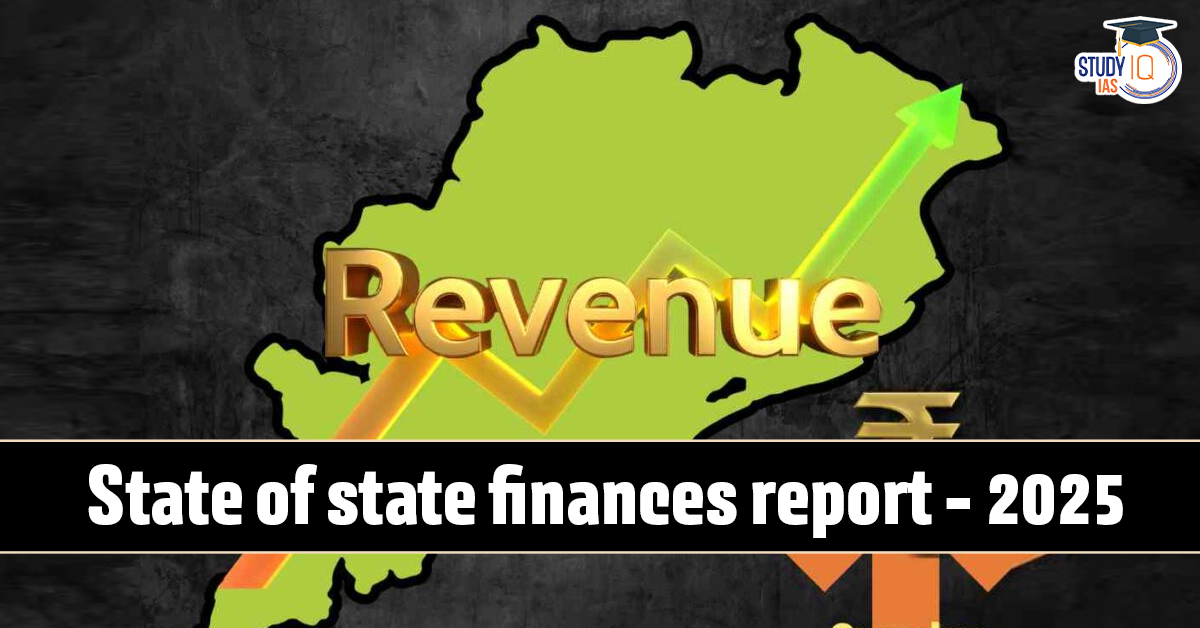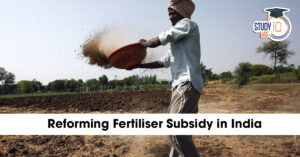Table of Contents
The State of State Finances 2025 Report, released by PRS Legislative Research, provides an in-depth analysis of the fiscal position of Indian states.
The report warns that rising committed expenditures, declining own-tax revenues, and mounting debt burdens are eroding the fiscal autonomy of states, leaving limited room for developmental spending.
As India aims for high and inclusive growth, states’ fiscal health becomes crucial since they are responsible for the majority of social sector and infrastructure spending.
Key Highlights of the State of State Finances Report 2025
High Committed Expenditure
-
In 2023–24, Indian states spent 62% of their total revenue receipts on salaries, pensions, interest payments, and subsidies.
-
This limits the ability of states to invest in new welfare and infrastructure projects.
-
Rising pension liabilities and salary revisions have further tightened state finances.
Implication: Development-oriented expenditure is being crowded out by mandatory recurring payments.
Decline in GST Revenue Share
-
Revenue from GST-subsumed taxes has fallen from 6.5% of GDP (2015–16) to 5.5% of GDP (2023–24).
-
The 15th Finance Commission had projected a medium-term GST revenue-to-GDP ratio of 7%, indicating a shortfall.
-
The decline has weakened the own-tax capacity of states, making them more dependent on the Centre.
Reason: Frequent GST rate cuts, revenue compensation expiry, and compliance issues have reduced state collections.
Reduced Untied Transfers
-
Untied transfers (funds without conditional usage) have declined to 64% under the 15th Finance Commission, reducing states’ spending flexibility.
-
More funds are now allocated as tied grants linked to centrally sponsored schemes.
Impact: States have less freedom to decide spending priorities based on local needs.
Rising Debt Burden
-
The aggregate outstanding debt of states has reached 27.5% of GDP (2024–25), exceeding the FRBM target of 20%.
-
Only Gujarat, Maharashtra, and Odisha currently meet the FRBM benchmark.
-
States like Punjab, Kerala, and West Bengal have significantly high debt levels.
Consequence: Higher debt = higher interest burden, leaving less fiscal space for development spending.
Interest Payments Growing Rapidly
-
Between 2016–17 and 2024–25, states’ interest payments grew by an average of 10% annually, faster than their revenue growth.
-
Interest payments are now one of the fastest-growing components of state budgets.
Concern: Persistent debt-service costs risk crowding out essential public services.
Unconditional Cash Transfers for Women
-
As of 2025–26, 12 states have launched unconditional cash transfer schemes for women (e.g., Ladli Behna in Madhya Pradesh, Magalir Urimai Thogai in Tamil Nadu).
-
While these programmes enhance welfare, they also add fiscal strain in states with already tight budgets.
Implication: The rise in populist schemes could undermine fiscal consolidation efforts.
Growing Income Disparity Among States
-
Per-capita income gaps between richer and poorer states are widening.
-
High-income states like Maharashtra, Gujarat, Karnataka generate higher tax revenues and spend more on development.
-
Lower-income states like Bihar and Uttar Pradesh remain dependent on central transfers.
Result: Fiscal inequality among states is increasing, challenging the principles of cooperative federalism.
Key Fiscal Indicators (2024–25)
| Parameter | Finding / Value |
|---|---|
| Committed Expenditure (as % of revenue) | 62% |
| Debt-to-GDP Ratio | 27.5% |
| FRBM Target | 20% |
| GST Subsumed Taxes | 5.5% of GDP |
| 15th FC Projection | 7% of GDP |
| Untied Transfers | 64% of total transfers |
| Interest Payment Growth | 10% annually |
| States with Women’s Cash Schemes | 12 |
Fiscal Challenges Identified
-
Erosion of Fiscal Space:
High fixed costs leave little room for capital expenditure and innovation. -
Mounting Liabilities:
States rely increasingly on borrowings for revenue expenditure, violating fiscal prudence. -
Populist Spending:
Freebies and cash transfers are expanding faster than tax revenues. -
Decline in Revenue Autonomy:
Centralisation of taxation post-GST has reduced states’ own-source revenue control.
Way Forward: PRS Recommendations
Enforce Fiscal Discipline
-
Reduce revenue deficits and avoid borrowing for routine expenses.
-
Eliminate off-budget borrowings that obscure real fiscal data.
-
Strengthen adherence to FRBM targets.
Rationalise Expenditure
-
Prioritise capital spending on infrastructure, health, and education.
-
Control subsidies and cash transfers that strain budgets.
-
Rationalise pension and salary outgo through reforms.
Boost Revenue Generation
-
Simplify GST structure and improve tax compliance.
-
Enhance non-tax revenue via:
-
User charges
-
Mining royalties
-
Property tax and excise reforms
-
Asset monetisation
-
Strengthen Fiscal Federalism
-
Increase untied transfers to give states more flexibility.
-
Empower states to innovate in local taxation and borrowing frameworks.
Reduce Debt to GDP Ratio
-
Gradually bring state debt closer to 20% of GDP to manage interest costs.
-
Link borrowing limits with fiscal performance indicators.
Why This Report Matters
-
States account for 60% of total public spending and are key drivers of social and infrastructure investment.
-
A fiscally weak state sector can slow India’s growth and derail national targets like Viksit Bharat 2047.
-
The report calls for a rebalancing of welfare commitments and fiscal discipline.
Conclusion
The State of State Finances 2025 Report highlights a crucial fiscal reality:
India’s states are facing tight fiscal constraints amid growing welfare expectations and declining revenue independence.
For India to sustain its growth ambitions, states must strike a balance between social commitments and fiscal prudence, strengthen revenue efficiency, and work in tandem with the Centre to achieve long-term fiscal sustainability.


 National Maritime Heritage Complex (NMHC...
National Maritime Heritage Complex (NMHC...
 Reforming Fertiliser Subsidy in India: N...
Reforming Fertiliser Subsidy in India: N...
 Micrometeoroids: Tiny Space Particles, M...
Micrometeoroids: Tiny Space Particles, M...

























